Soyuz 2-1v Launch Vehicle
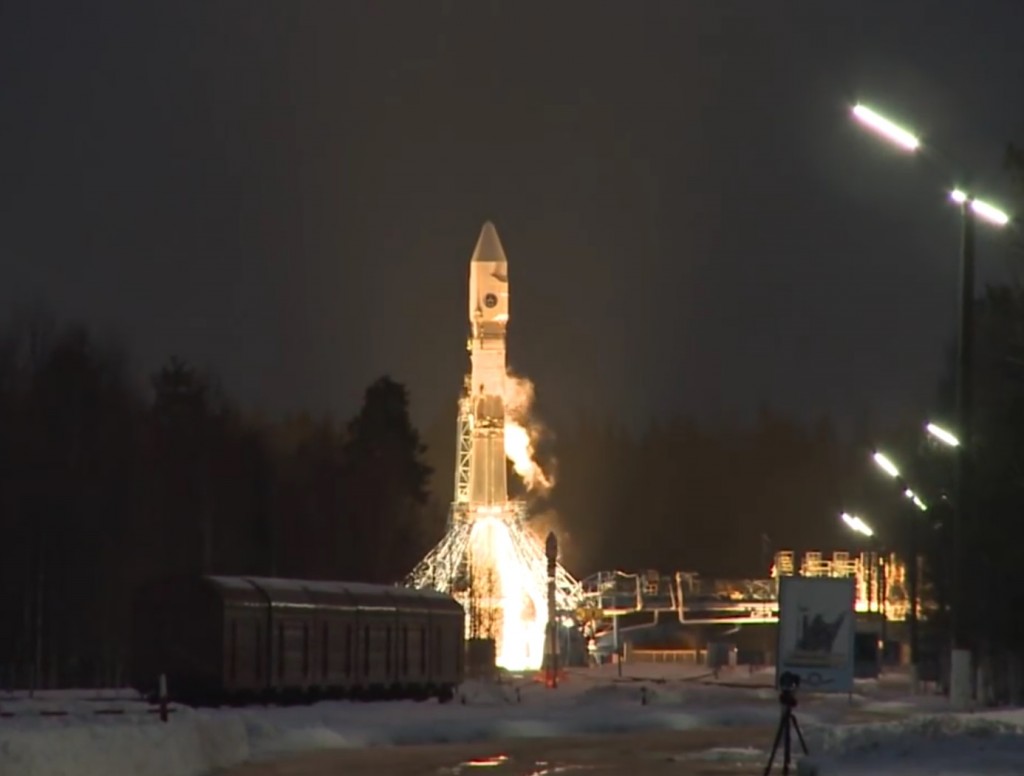
The Soyuz 2-1v, sometimes called Soyuz-1, is a light-lift variant of the Soyuz 2-1 rocket with a Low Earth Orbit capability of around three metric tons. The launch vehicle was conceptualized to bridge a gap in lift capability and prepare for the retirement of the Rockot launch vehicle.
Soyuz 2-1v does not feature the iconic shape of the R7-type Soyuz that has been flying since 1957 as the launcher is not using any strap-on boosters. Also, Soyuz 2-1v uses a different first stage propulsion system with some additional changes to the Block A Core Stage. The second stage is identical to that of the Soyuz 2-1B and Soyuz 2-1v also uses the upgraded Control System switching from analog to digital control system to make the Soyuz launcher more flexible. As another change to the other Soyuz 2-1 versions, Soyuz 2-1v can be equipped with a newly developed Volga Upper Stage that provides re-start and precise injection capability.
Soyuz began development in the 1950s as R-7 Intercontinental Ballistic Missile making 28 launches from 1957 to 1961. In its history dating all the way back to the beginnings of space flight, Soyuz made over 1,800 flights going through a number of generations as the launcher was modified and improved. Today, there are a number of Soyuz versions available.
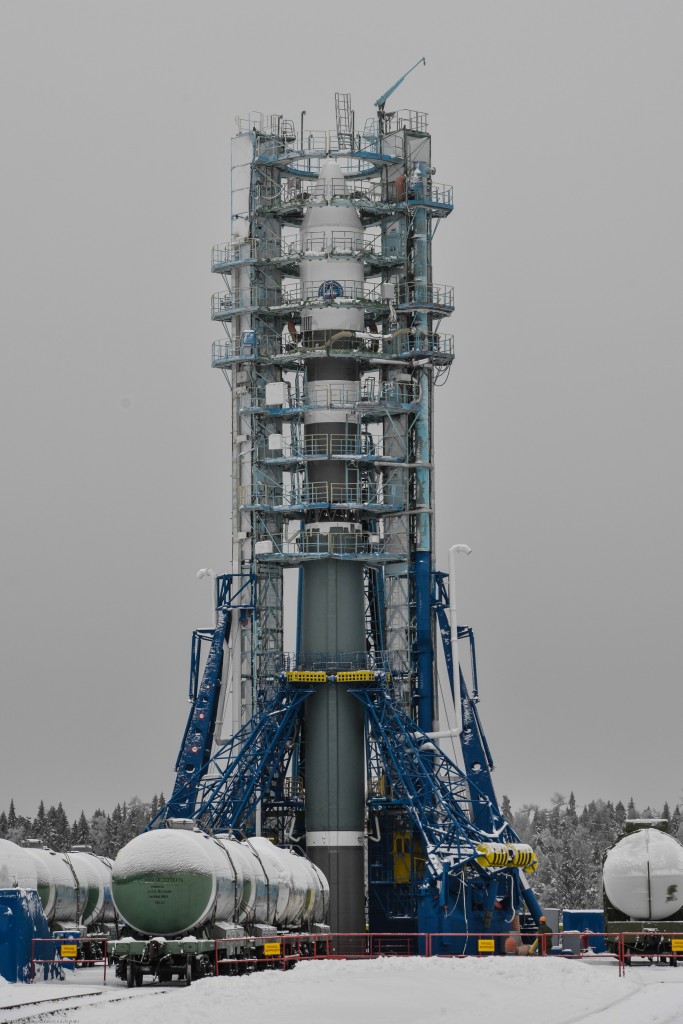
The Soyuz U vehicle is primarily used to launch Progress Spacecraft to the International Space Station with very few launches dedicated to delivering military satellites to orbit. Soyuz FG is used to launch crewed Soyuz spacecraft. FG and U use the old analog Flight Control System while the new Soyuz 2-1 uses digital avionics. The Soyuz 2-1 will replace the Soyuz U in the coming years, but Soyuz FG flights will continue until at least 2020.
Soyuz 2-1 comes in a 2-1A version using the standard RD-0110 engine on the Soyuz Upper Stage and 2-1B that features the more powerful RD-0124 closed cycle engine.
Soyuz 2-1v eliminates the boosters from the 2-1B and replaces the conventional RD-118 engine of the core stage with an NK-33 and a four-chamber steering engine.
itially, the launcher is operated from the Plesetsk Cosmodrome, Russia and will be available for launches from the Baikonur Cosmodrome, Kazakhstan once testing is complete.
Like all other Soyuz launch vehicles, the Soyuz 2-1v is manufactured by TsSKB Progress, Samara that started development of the vehicle in 2008 with an expected development time of three to four years which was later accelerated to see the first launch of the vehicle in 2010. However, the revival of the NK-33 that had been in storage for decades took longer than expected and the design of the flight control system also required additional time as the 2-1v needed new flight software and modified avionics due to its different propulsion system. As the maiden flight slipped into 2011 and then into 2012, teams finished design operations in mid-2011 and began hardware testing.
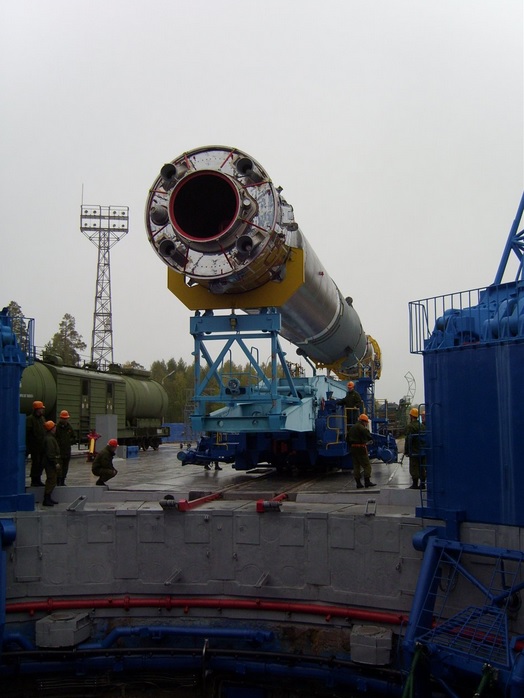
The first test article of the Soyuz 2-1v first stage was ready in late 2011 to begin testing early in 2012 featuring propellant loading tests before a hot-fire test in a test stand. In August 2012, the first test firing of the 2-1v first stage took place. The planned 200-second hot-fire test of the first stage and its NK-33 and RD-0110R steering engine ended after a few seconds in an uncontrolled shutdown of the RD-0110R that resulted in damage to the test article and test stand.
The test article was shipped back to TsSKB Progress for restoration that included extensive work on the damaged propulsion section and Kerosene tank. Parts from another existing operational Soyuz 2-1v were salvaged to repair the test article and ship it for a second test firing in February 2013. NK-33 test firings occurred throughout 2011 and 2012 in Russia to prepare for Soyuz 2-1v while the American company Aerojet performed test firings of the AJ-26 engine, a modified NK-33 for use aboard the Antares launch vehicle that was also preparing for its maiden flight at that time.
In the first half of 2012, the Soyuz 2-1v was delivered to the Plesetsk Cosmodrome for fit checks on the LC-43 launch pad that was modified with a new hold-down and umbilical system to accommodate the Soyuz 2-1v without boosters. The Soyuz spent several days at the pad for acceptance testing of the ground systems and a full-scale propellant loading test.
Soyuz 2-1v made its second test firing in March 2013. The test was declared a success although the propulsion system was shut down 150 seconds into a 202-second burn due to a leak in a fuel line related to the RD-0110R. However, the test article used some non-standard propellant lines that would not be used on the flight version so that the test was classed as success – clearing the way to the launch pad for the Soyuz 2-1v.
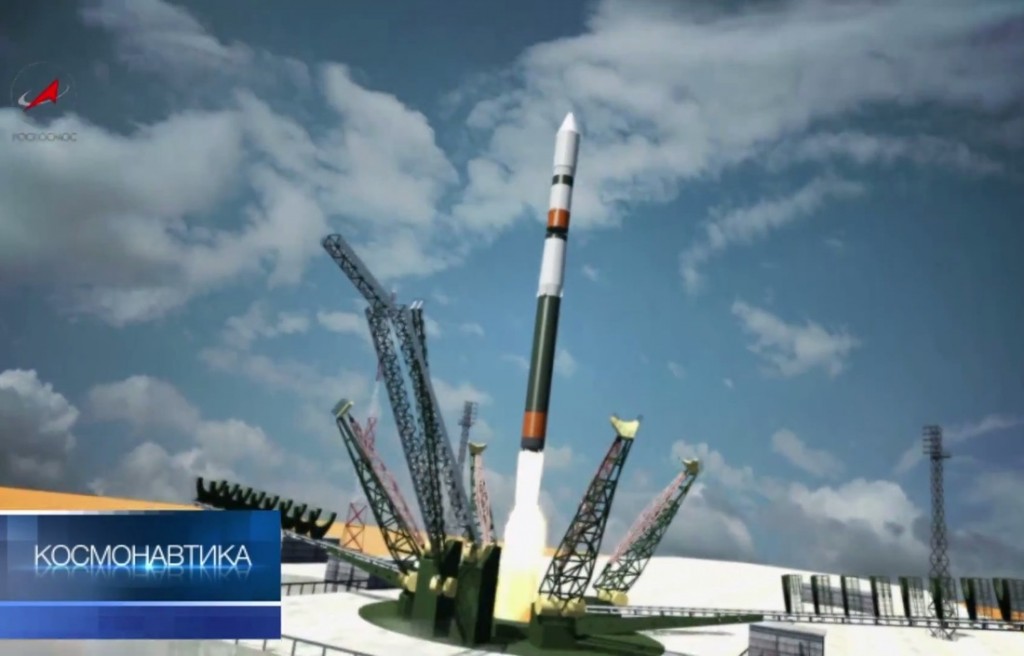
The first launch of the Soyuz 2-1v was pushed from September into November and then to late December 2013. Soyuz 2-1v made its way to the launch pad on December 18 for a number of testing activities as part of a two-day campaign that featured fueling tests of the new vehicle to validate launch vehicle and modified launch pad systems.
After a few more days of launch delays, Soyuz 2-1v was cleared for launch on December 28, 2013 successfully demonstrating its capabilities including the Volga Upper Stage – delivering the small Aist #1 satellite and two SKRL-756 calibration spheres to orbit.
| Type | Soyuz 2-1v |
| Length | 44m |
| Diameter | 2.95m |
| Launch Mass | 157,000kg |
| Stages | 2 + Optional Volga Upper Stage |
| Boosters | None |
| Mass to LEO | 2,800kg (Plesetsk, 62.8°) |
| Mass to LEO | 3,000kg (Plesetsk, 82.4°) |
| Mass to LEO | 2,630kg (Plesetsk, 99.3°) |
| Mass to LEO | 2,850kg (Baikonur, 56.8°) |
| Mass to SSO | 1,400kg (98.7°, with Volga) |
| Mass to LEO | 1,400 (1,500km, 82.4°, Volga) |
Soyuz 2-1v Specifications
Soyuz 2-1v is a two-stage launch vehicle that can be outfitted with an optional Upper Stage for additional performance and to perform complex mission profiles with precise injection capability.
Overall, the launcher stands 44 meters tall and has a maximum diameter of 2.95 meters with a total liftoff mass of 157,000 to 160,000 Kilograms.
The vehicle can deliver payloads of up to 3,000 Kilograms to Low Earth Orbit while Sun-Synchronous capability with the Volga Upper Stage is 1,400 Kilograms.
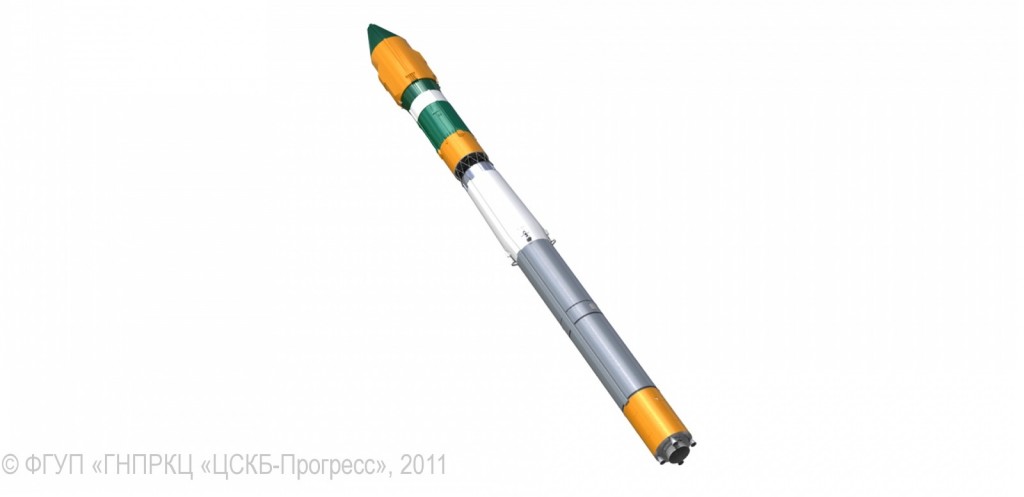
First Stage
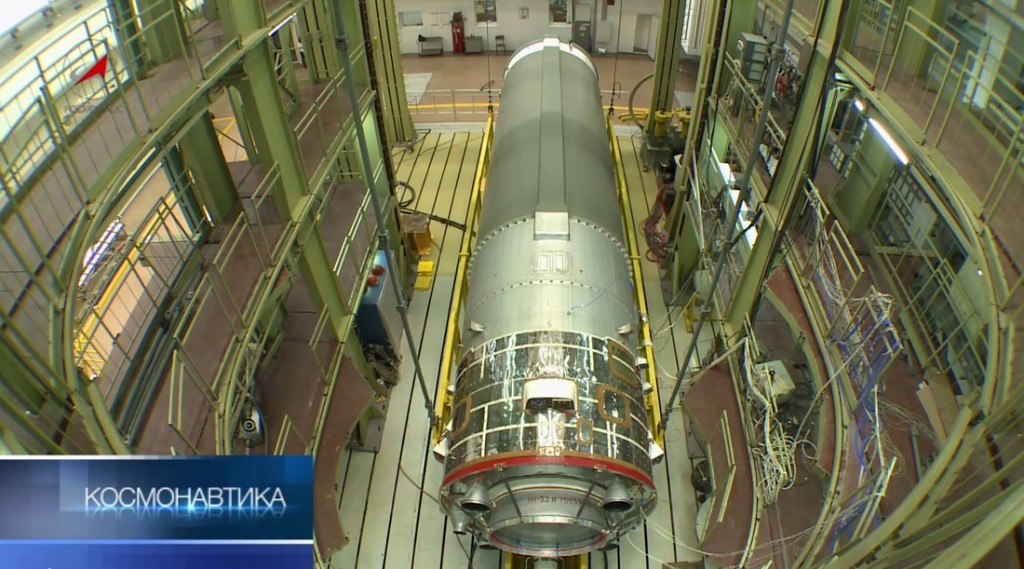
| Type | Modified Block A |
| Length | 27.8m (with Interstage) |
| Diameter | 2.95m |
| Inert Mass | 9,300kg |
| Launch Mass | 129,000kg |
| Fuel | Kerosene |
| Oxidizer | Liquid Oxygen (Sub-Cooled) |
| LOX Tank | Aluminum Alloy |
| RP-1 Tank | Aluminum Alloy |
| Tank Design | Separate Bulkheads |
| Guidance | From second Stage |
| Tank Pressurization | Heated Helium |
| Main Propulsion | 1 NK-33 |
| Throttling | 56% – 108% |
| NK-33 SL Thrust | 1,510kN (100%) – 1,630kN (108%) |
| NK-33 Vac Thrust | 1,682kN (100%) – 1,815kN (108%) |
| Throttling | 56% – 108% (Up to 135% achieved) |
| Impulse SL | 297s |
| Impulse Vac | 331s |
| Engine Length | 3.71m |
| Engine Diameter | 1.45m |
| Engine Dry Weight | 1,240kg |
| Thrust to Weight | 137 |
| Chamber Pressure | 145bar |
| Area Ratio | 27 |
| Ox. To Fuel Ratio | 2.8 |
| Restart Capability | No |
| Steering Engine | RD-0110R |
| Chambers | 4 |
| RD-0110R SL Thrust | 213.6kN |
| Vacuum Thrust | 279.3kN |
| Impulse SL | 241s |
| Impulse Vac | 315s |
| Engine Weight | 870kg (with aft ring section) |
| Vehicle Control | RD-0110R Hydraulic TVC |
| Burn Time | ~210sec |
| Stage Separation | Pyro Bolts, Hot Staging |
The first stage of the Soyuz 2-1v shares some commonalities with the Soyuz 2-1 vehicles, but a number of components are changed – primarily related to the different propulsion system used on the Soyuz 2-1v.
The overall dimensions of the first stage remain the same with a total length of 27.8 meters and a maximum diameter of 2.95 meters, but the diameter of the lower section of the stage is increased to 2.66 meters.
The first stage uses Liquid Oxygen oxidizer and Kerosene fuel that are stored in two cylindrical tanks with separate bulkheads. On top of the core stage is a Truss Segment that interfaces with the upper stage and includes stage separation mechanisms.
The oxidizer tank is located above the fuel tank and consists of Aluminum alloy shells of variable thickness that are welded together using proven techniques.
Submerged in the LOX tank for gas-storage efficiency are spherical Helium bottles. Helium loading begins once the bottles are submerged in Liquid Oxygen in order to be chilled down to accommodate the Helium which is used to pressurize both propellant tanks of the first stage. The other Soyuz versions use Nitrogen for tank pressurization.
The upper portion of the Core Stage also hosts interfaces for the hold-down arms that are used to hold the Soyuz in position on the launch pad and release it for liftoff. The Kerosene tank also uses Aluminum alloy. It is comprised of a forward and aft bulkhead and a riveted cylindrical shell.
The Kerosene tank also facilitates the LOX feedline from the LOX tank above to the engines. In its aft section, the first stage also features hold-down arm attachments that are used by the arms of the launch pad structure.
In the aft section of the first stage is the large propulsion module that features a single NK-33 main engine and a four-chamber RD-0110R steering engine.
NK-33 engines were originally built for the massive Soviet N1 Moon Rocket in the 1960s and 70s and have since been in storage for decades before being “re-discovered” for use on space launch vehicles.
A number of NK-33 engines are part of the existing inventory of engine manufacturer Kuznetsov Design Bureau and are being refurbished for use on the Soyuz 2-1v and exported to the United States where the engines are modified by Aerojet Rocketdyne and used as AJ-26 engines on Orbital Sciences’ Antares rocket.
NK-33 has been derived from the NK-15 engine that was used on the ill-fated N1 moon rocket. The four N1 flights that took place from 1969 to 1972 used the NK-15 while later flights were planned to use the NK-33, but were canceled after the program turned out to be a failure and the race to the Moon was lost to the United States.
The existing NK-33 engines ended up in a warehouse where they were sitting for 30 years before being considered for use on modern launch vehicles.

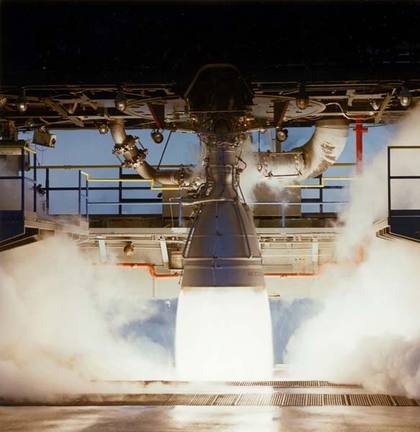
The engine is a regeneratively cooled staged combustion engine with oxygen-rich preburners to drive the turbopumps. The engine operates at a high chamber pressure of 145 bar. NK-33 provides a maximum sea level thrust of 1,630 Kilonewtons with length of 3.7 meters, an engine diameter of 1.45 meters and dry weight of 1,235kg. The engine can lift 137 times its weight and provides a vacuum impulse of 331s. Maximum vacuum thrust is 1,815kN.
In terms of thrust-to-weight ratio, the engine is one of the most powerful in the world, only falling short to the SpaceX Merlin 1D engine that is used on the Falcon 9 rocket.
NK-33 provides throttle capability from 56 to 108% of rated performance, however its full thrust setting during flight is usually 105%. In tests, NK-33 achieved 135% of rated performance thrust without failing.
The NK-33 requires sub-cooled Oxygen with a temperature below its boiling point of -183-degrees Celsius to cool the turbopump bearings that would otherwise fail. Also, sub-cooled LOX has a higher density, close to that of Kerosene, reducing required tank volume and overall launch vehicle mass and allowing the engine to use a single rotating shaft for both turbopumps.
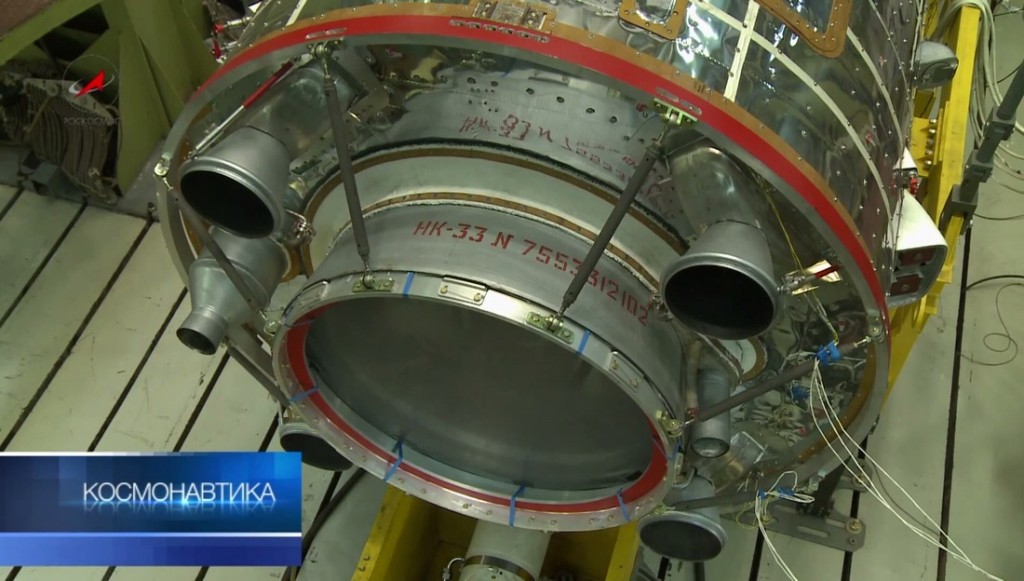
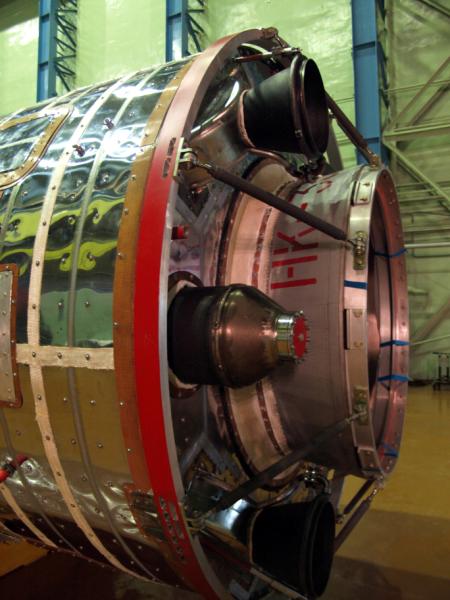
The N-1 moon rocket used -192°C LOX while Antares is using -195°C oxidizer. For Soyuz 2-1v, a compromise had to be found since the RD-0110R steering engine of the first stage does not use sub-cooled LOX. Because of that, the LOX temperature for Soyuz 2-1v is -187 degrees Celsius. What type of sub-cooler is used at the launch pad is not known – usually a cryogenic liquid Nitrogen heat exchanger is used.
On Soyuz 2-1v, the NK-33 is attached to the aft bulkhead of the first stage to transfer loads to the rocket structure. The engine is fixed and can not be gimbaled. NK-33 is enclosed in the Tail Compartment called Хвостовой Отсек that features stringers and structural rings as it hosts the four-chamber RD-0110R engine that is used for vehicle control during first stage flight. The Tail Compartment is built to transfer loads from the steering engine to the launcher and also facilitate the lower support arms of the launch pad structure. The Tail Compartment also includes access doors and a number of interfaces.
The RD-0110R engine was designed by KBKhA and is based on the RD-0110 that is used on the third stage of the Soyuz 2-1A, U and FG vehicles. Modifications on the engine are mostly related to shortening the nozzles for operation at Sea Level and the more dense atmosphere and building an engine frame to accommodate the large NK-33 nozzle.
The engine is an open cycle engine featuring four combustion chambers that share the LOX and Kerosene turbopumps. RD-0110R delivers 213.6 Kilonewtons of Sea Level Thrust that increases to 279.3 Kilonewtons in vacuum conditions. The engine was optimized for a high-impulse in vacuum by increasing the geometric expansion by deflecting the nozzles of the engine. With the structural ring that facilitates the four nozzles, RD-0110R weighs 870 Kilograms.
A hydraulic Thrust Vector Control System is used to individually gimbal the four nozzles of the engine in order to achieve three-axis control during first stage flight. RD-0110R is equipped with a heat exchanger that is used to heat up Helium gas that is used to pressurize the propellant tanks of the Soyuz. First stage burn time is approximately 210 seconds.
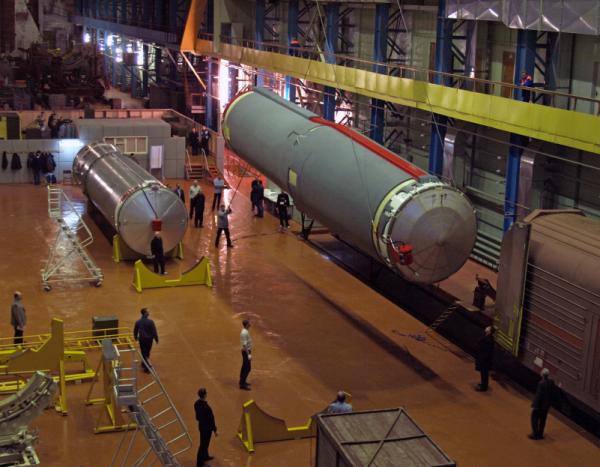
The initial flights of the Soyuz 2-1v will use the NK-33 engine before the vehicle switches to the RD-193 engine that is derived from the RD-191 that is being developed for the Angara rocket.
The engine is developed by NPO Energomash and is a closed-loop single-chamber engine that is 3.02 meters long and 2.1 meters in diameter with a dry weight of about 1900 Kilograms. RD-193 provides 2,085 Kilonewtons of vacuum thrust.
The first stage separates from the second stage in hot staging mode.
About two seconds after the shutdown of the first stage, the second stage ignites its engine and at the same time, the pyrotechnic separation system is initiated to physically separate the two stages, allowing the first stage to be pushed away by the exhaust of the second stage engine.
Second Stage
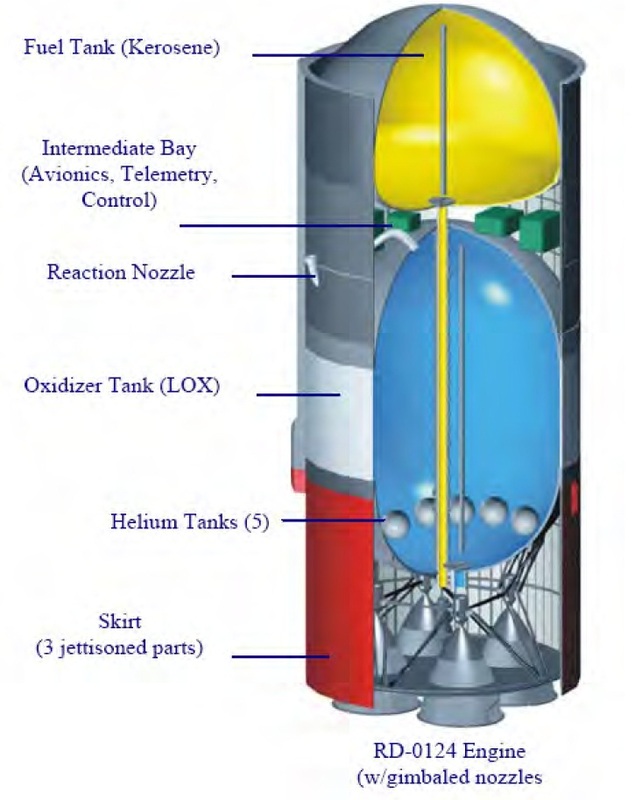
| Diameter | 2.66m |
| Length | 6.74m |
| Empty Mass | 2,355kg |
| Launch Mass | 27,755kg |
| Oxidizer | Liquid Oxygen |
| Fuel | Rocket Propellant 1 |
| LOX Mass | 17,800kg |
| Kerosene Mass | 7,600kg |
| Tank Pressurization | Helium |
| Propulsion | 1 RD-0124 |
| Engine Type | Staged Combustion Engine |
| Cycle | Closed Cycle |
| Propellant Feed | Turbopump |
| Comb. Chambers | 4 |
| Total Thrust Vac | 294.3kN |
| Engine Length | 1.58m |
| Engine Diameter | 2.40m |
| Engine Dry Weight | 572kg |
| Thrust-to-Weight | 62.5 |
| Burn Time | 230s |
| Specific Impulse | 359s (Vac) |
| Chamber Pressure | 162bar |
| Restart Capability | No |
| Ox to Fuel Ratio | 2.6 |
| Turbine Temp. | 973K |
| LOX Flow Rate | 56.7kg/s |
| RP-1 Flow Rate | 23.9kg/s |
| Attitude Control | Engine gimbaling; Reaction Nozzle |
| Shutdown | Commanded Shutdown |
The second stage of the Soyuz 2-1v is identical to that of the Soyuz 2-1B. It is 6.74 meters in length and 2.66 meters in diameter using the conventional design with the fuel tank being placed on top of the oxidizer tank.
Both tanks use individual bulkheads. The stage has an empty mass of 2,355 Kilograms and a launch mass of about 27,750 Kilograms, also using Liquid Oxygen as oxidizer and Kerosene fuel.
The Avionics of the Soyuz Launcher are also installed on the Upper Stage. These present the main difference between Soyuz 2 and other versions. The control system features a digital onboard computer providing all vehicle commanding and guidance is provided by a 3-axis Inertial Measurement Unit. The control equipment provides vehicle control, telemetry and navigation for the entire flight and issue all vehicle commands autonomously. The equipment is located in the area between the two propellant tanks inside a small equipment bay. The third stage tanks are capable of holding 25,400 Kilograms of Propellants for consumption by the RD-0124 engine.
The RD-0124 is a four-chamber engine with a single Gas Generator and turbopump assembly supplying all combustion chambers. This engine is derived from the RD-0110, but is a closed-cycle gas-generator type engine. Overall, RD-0124 is 2.4 meters in diameter and 1.58 meters tall with an empty mass of 572 Kilograms. The engine delivers a thrust of 294.3 Kilonewtons (30,400kgf) and has a specific impulse of 359 seconds – a major improvement over the RD-0110 due to the use of a closed cycle and the higher chamber pressure of that design.
The RD-0124 uses a typical staged combustion cycle of Russian engines with an Oxygen-rich gas generator in which the entire LOX flow is combusted with a small portion of the fuel flow to create a hot high-pressure gas to drive the turbine of the engine which powers the turbopumps. The rest of the Kerosene is used for cooling of the chambers before being injected into the combustion chambers and burned with the oxygen-rich gas.
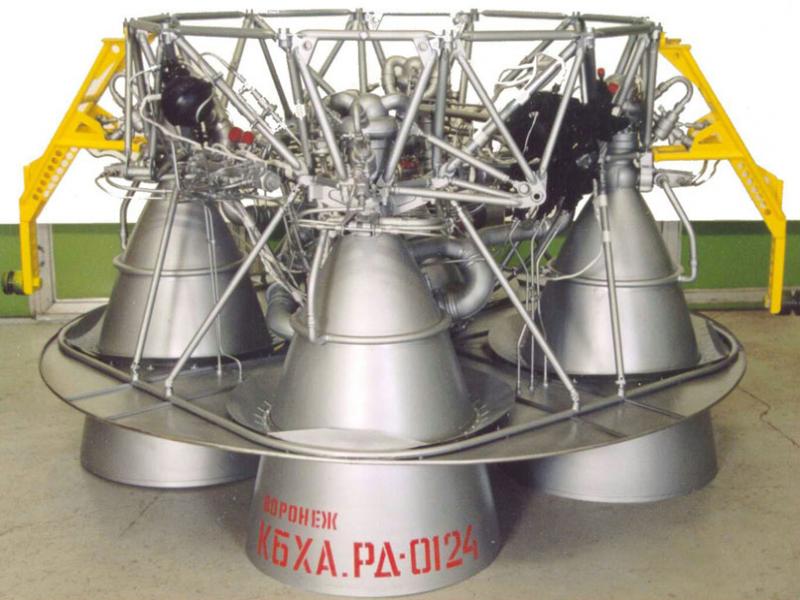
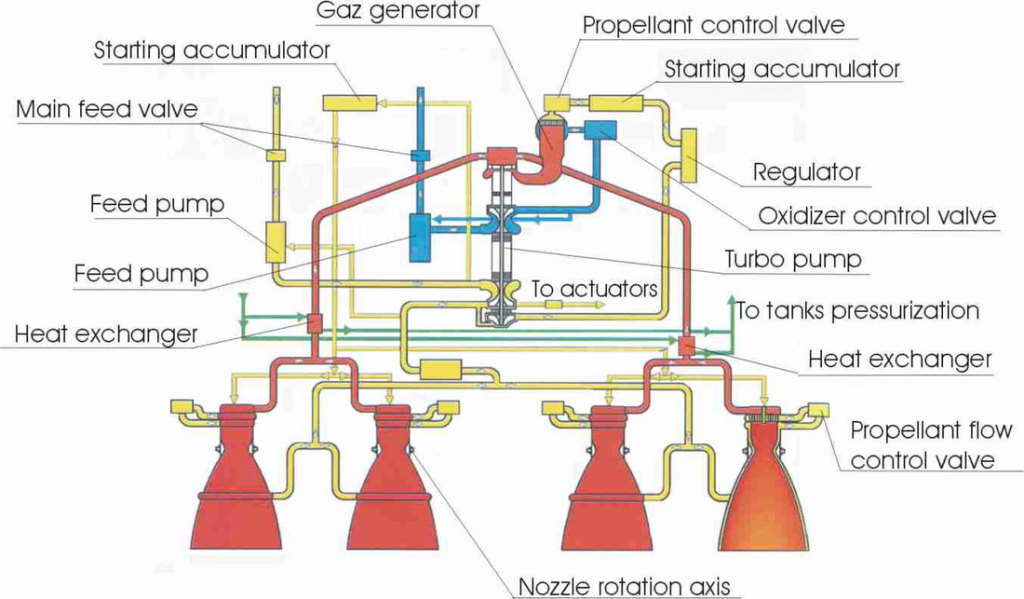
Propellants entering the engine are pumped to the main turbopumps by separate boost pumps in the Kerosene and LOX lines needed to reach the proper inlet pressure of the main pumps. The turbo-axial boost pumps are similar in design – each unit includes one rotating part that consists of axial pump wheels and a hydraulic turbine, brazed or welded onto the pump wheel external diameter.
The boost pump of the fuel inlet is driven by the high-pressure tapoff from the second stage Kerosene turbopump that re-enters the propellant inflow after passing through the turbine. On the LOX side, the boost pump turbine uses a similar scheme – it is powered by a fraction of LOX from the turbopump that also re-enters the feedline.
RD-0124A uses a single shaft to which the LOX turbopump and a two-stage Kerosene turbopump are mounted. The shaft is driven by a turbine powered by the high-pressure gas produced by the Gas Generator.
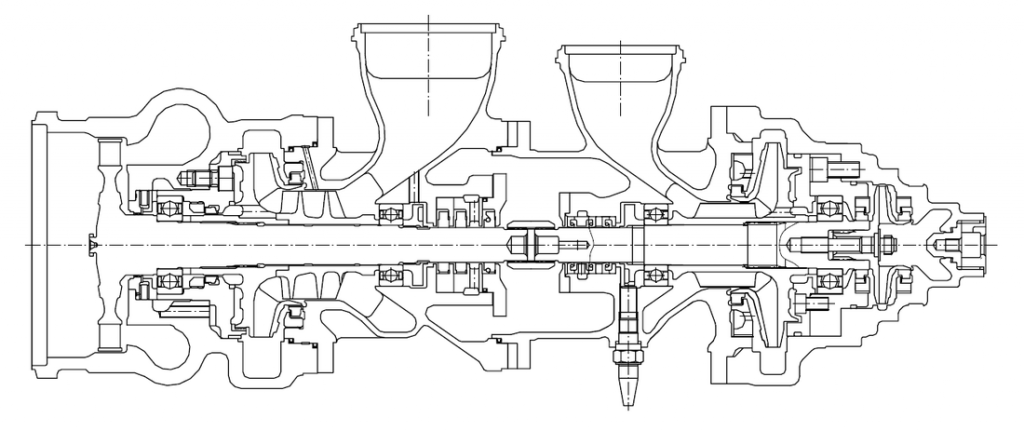
The turbopump housings and impellers are castings made from stainless steel. The impeller seals use bronze floating rings and the pump rotors employ a thrust balance system to ensure a proper axial balance. Both pumps use their respective propellants to lubricate and cool the turbopump ball bearings. The LOX turbopump operates at an inlet pressure of around 3 bar and an outlet pressure of 363 bar at a LOX mass flowrate of 56.7 Kilograms per second. For the Kerosene pump, inlet pressures of under 2 bar are sufficient to allow the pump to generate an outlet pressure of 366 bar at a flowrate of 23.9kg/sec.
The entire LOX flow from the turbopump is passed through an oxidizer control valve to the Gas Generator where it combusts the Kerosene supplied by the second stage of the turbopump via a propellant control valve and a regulator that adjusts the mixture ratio that is normally set at 2.34. The Gas Generator produces a hot gas (973K) entering the turbine at a pressure of 319 bar and a flowrate of 59.85 Kilograms per second. Spinning the turbine at 39,000 rpm, the hot gas exits at a pressure of 185 bar, being directed on two paths that are then further separated into four lines to feed the four combustion chambers.
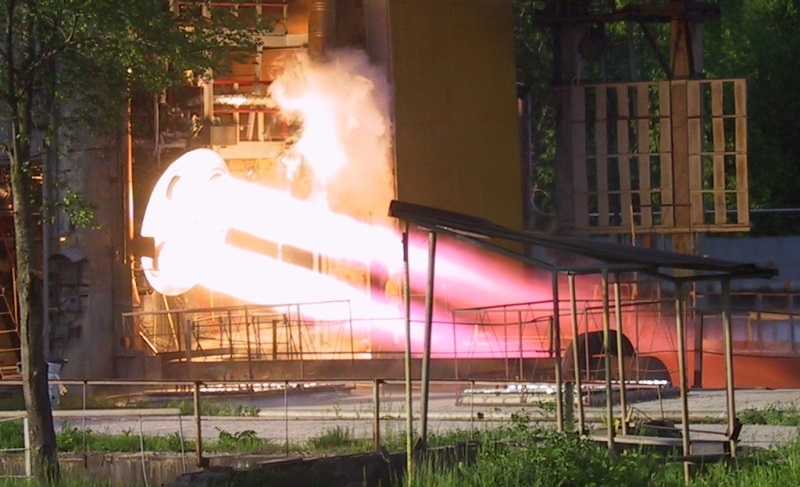
While still at the two-line stage, the hot gas passes through heat exchangers to warm up the Helium gas supply for tank pressurization. Helium is stored in five spherical tanks submerged in the LOX tank and supplied to the engine to be heated up and pressurized in order to be able to pressurize the Kerosene and LOX tank via a number of pressure regulators and valves that ensure proper pressure levels are maintained.
The Kerosene from the first stage turbopump is directed to the combustion chambers where it is used to cool the chambers and nozzles as part of two circuits per engine chamber. Afterwards, the Kerosene enters the combustion chambers where it is burned by the oxygen-rich gas generator gas supply. The chambers use a mixing head for a stable combustion process and operate at a nominal chamber pressure of 157 bar.
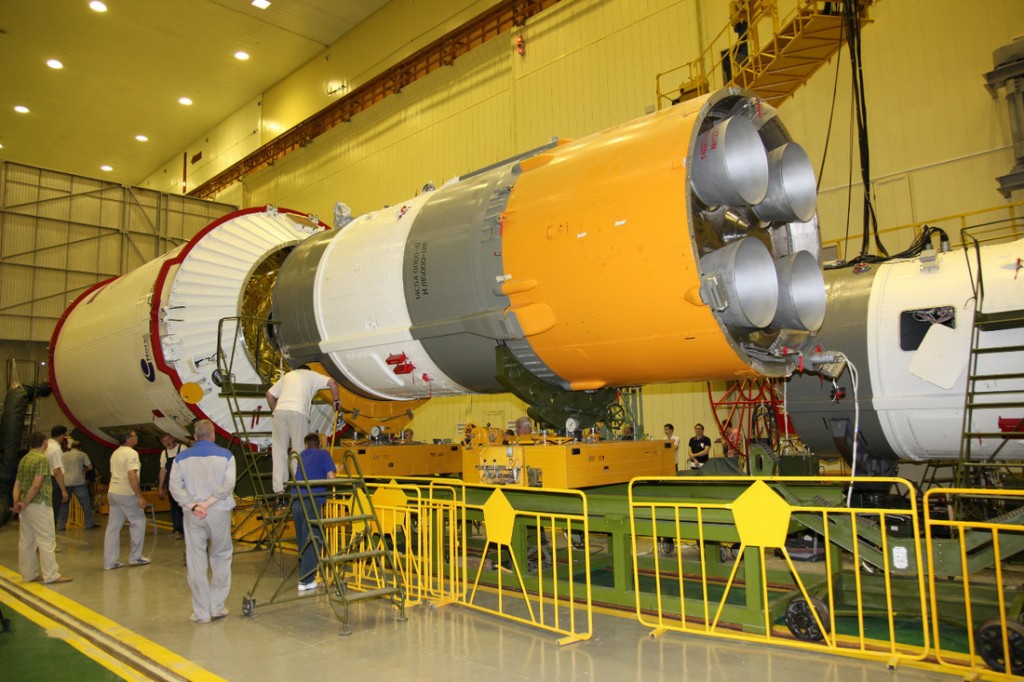
Engine ignition is accomplished by injecting a pyrophoric substance into the Gas Generator and the four chambers that ignites when coming into contact with the oxygen. Once started, the combustion process is sustained by injecting the Kerosene into the GG and combustion chamber. As the gas generator starts spinning the turbine, the turbopumps begin supplying propellants to the Gas Generator and chambers to continue the combustion process. The pyrophoric igniter fluid is stored in accumulators just ahead of the Gas Generator and the chambers that release the fluid once the Kerosene pressure is sufficient to break the membranes.
A small fraction of the Kerosene flow from the first turbopump stage is used to drive the hydraulic actuators of the engine that allow each chamber of be moved by +/-3.5 degrees in one direction. With four chambers being able to move along different directions, attitude control in pitch, yaw and roll can be accomplished. Following payload separation, the Block I stage uses a reaction nozzle that vents the oxygen tank in order to move away from the separated spacecraft.
Volga Upper Stage

| Type | Volga Upper Stage |
| Length | 1.03m |
| Diameter | 3.1m |
| Inert Mass | 890kg |
| Launch Mass | 1,190kg to 1,790kg |
| Fuel | Unsymmetrical Dimethylhydrazine |
| Oxidizer | Nitrogen Tetroxide |
| Propellant Load | Variable – 300 to 900kg |
| Main Engine Thrust | 2.94kN |
| Vac Impulse | 307s |
| Burn Time | Up to 900 sec |
| Attitude Control | Thruster System (derived from Ikar) |
| Restart Capability | Yes |
| Navigation Sensors | IMU, 2 БОКЗ-М60 Star Trackers |
| On-Orbit Life | 24 Hours |
For additional performance and precise insertion capability, Soyuz 2-1v can be outfitted with a Volga Upper Stage. This new tye of small upper stage uses heritage components that were used on the Ikar Upper Stage that was inaugurated in 1999 and was in turn based on the propulsion module of the classified Yantar reconnaissance spacecraft.
Volga is a small upper stage that is 3.1 meters in diameter and 1.03 meters long with an empty mass of 890 Kilograms. The stage uses hypergolic propellants, Unsymmetrical Dimethylhydrazine and Nitrogen Tetroxide. The Upper Stage can launch with propellant loads of 300 to 900 Kilograms based on specific mission requirements.
Volga is equipped with a single main engine providing 2.94 Kilonewtons of vacuum thrust and a specific impulse of 307 seconds. The engine is a non-gimbaling engine. Vehicle control is provided by an attitude control system consisting of a number of thrusters installed on the upper stage.
The Volga upper stage uses an Inertial Measurement Unit for navigation as well as Star Trackers that may be used during long and complex ascent missions. Volga also has the capability of incorporating Glonass Navigation Signals for vehicle control. The upper stage is re-startable and can support a large number of burns.
Volga can operate in orbit for up to 24 hours using on-board batteries, but typical missions are not expected to last more than two hours.
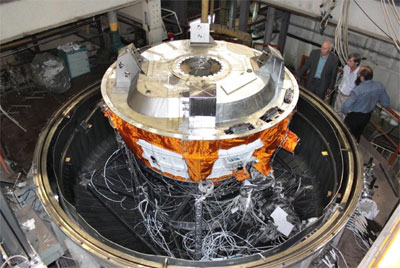
Payload Fairing
The Payload Fairing is positioned on top of the stacked vehicle and its integrated payloads. It protects satellites or other spacecraft against aerodynamic, thermal and acoustic environments that the vehicle experiences during atmospheric flight. When the launcher has left the atmosphere, the fairing is jettisoned by pyrotechnical systems. It is separated when aerodynamic and thermal loads are acceptable for the spacecraft to be exposed after the launcher has left the dense portion of the atmosphere.
Soyuz 2-1v uses the standard 3-meter Soyuz fairing.
